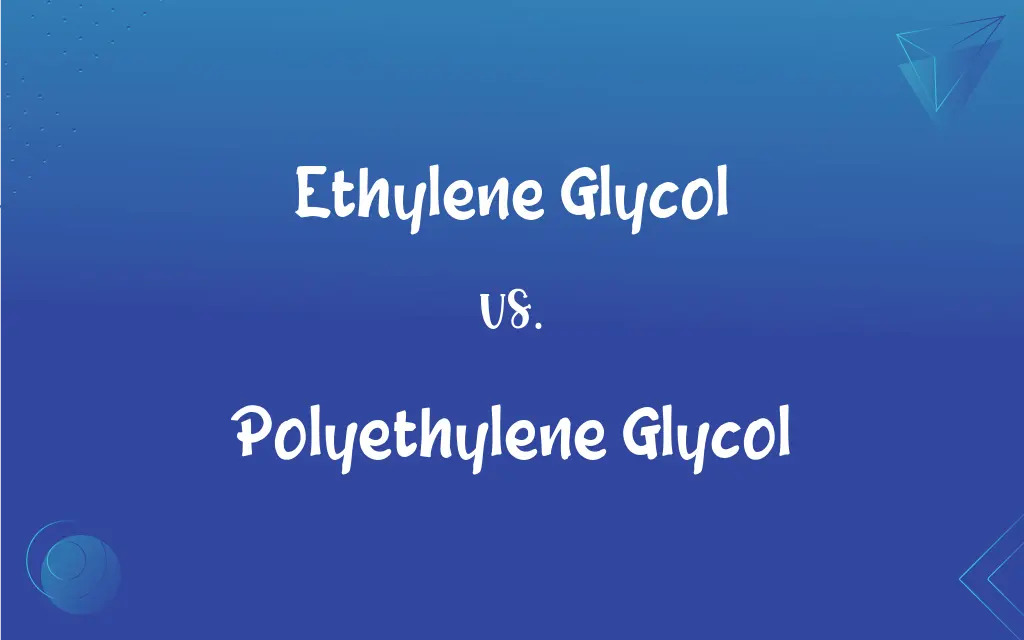Ethylene Glycol vs. Polyethylene Glycol: What's the Difference?
Edited by Janet White || By Harlon Moss || Updated on October 17, 2023
Ethylene glycol is a toxic liquid used in antifreeze, while polyethylene glycol is a non-toxic compound used in medicines and cosmetics. Both are derived from ethylene but have different molecular structures and uses.

Key Differences
Ethylene glycol and polyethylene glycol, although sharing a common base in the name "ethylene," are distinctly different in their chemical composition and applications. Ethylene glycol is a simple diol with the formula C2H6O2. It is a colorless, odorless, sweet-tasting liquid that is highly toxic to humans if ingested.
In contrast, polyethylene glycol, abbreviated as PEG, is a polyether compound, meaning it contains multiple ether groups. It comes in various molecular weights, determining its viscosity and melting point. Polyethylene glycol is non-toxic and is frequently found in a range of products, from skin creams to laxatives.
The primary use of ethylene glycol is as an antifreeze in cooling and heating systems. It's also used in hydraulic brake fluids and in the manufacture of capacitors. Due to its sweet taste and high toxicity, there have been unfortunate cases of accidental or intentional ingestion leading to poisoning.
Polyethylene glycol, on the other hand, has a vast range of applications in the medical, pharmaceutical, and cosmetic industries. It serves as a solvent, plasticizer, surfactant, and in many other roles. Its versatility and safety profile make it a preferred ingredient in numerous products we encounter daily.
Comparison Chart
Molecular Structure
Simple diol (C2H6O2)
Polyether compound with varied molecular weights
ADVERTISEMENT
Toxicity
Highly toxic
Generally non-toxic
Primary Use
Antifreeze, hydraulic brake fluids
Medicines, cosmetics, solvents
Taste
Sweet
Generally tasteless or slightly bitter
Solubility
Soluble in water, alcohol, and ethers
Soluble in water, varies with molecular weight
Ethylene Glycol and Polyethylene Glycol Definitions
Ethylene Glycol
A common component in hydraulic brake fluids.
Ethylene glycol enhances the performance of braking systems.
ADVERTISEMENT
Polyethylene Glycol
A versatile substance with a range of molecular weights.
Depending on its molecular weight, polyethylene glycol can be a liquid or a solid.
Ethylene Glycol
A toxic diol used mainly as antifreeze.
Ethylene glycol poisoning can be fatal if not treated promptly.
Polyethylene Glycol
A substance often used in drug delivery for its solubility and safety.
Medications might include polyethylene glycol to enhance absorption.
Ethylene Glycol
A primary raw material in the production of polyester fibers and resins.
Ethylene glycol is crucial for producing many types of plastics.
Polyethylene Glycol
A surfactant and plasticizer in numerous products.
Polyethylene glycol improves the texture and spreadability of cosmetics.
Ethylene Glycol
A liquid with a high boiling point and excellent solvent properties.
Ethylene glycol's properties make it useful in industrial applications.
Polyethylene Glycol
A non-toxic polyether compound used in various industries.
Polyethylene glycol is often found in skin creams.
Ethylene Glycol
A colorless, sweet-tasting organic compound.
Despite its sweetness, ethylene glycol is hazardous when ingested.
Polyethylene Glycol
A common ingredient in over-the-counter laxatives.
Many laxatives use polyethylene glycol as their active ingredient.
FAQs
Is polyethylene glycol safe for consumption?
Yes, polyethylene glycol is non-toxic and used in many pharmaceuticals.
Why is ethylene glycol dangerous?
It's highly toxic when ingested and can lead to severe poisoning.
How can I identify ethylene glycol in products?
It might be listed as "ethylene glycol" or "1,2-ethanediol."
Are there alternatives to polyethylene glycol in products?
Yes, some products use alternatives for various reasons, such as sensitivities.
What is the primary use of ethylene glycol?
It's mainly used as antifreeze and in hydraulic brake fluids.
Why is ethylene glycol used in antifreeze?
Its low freezing point and high boiling point make it suitable.
How is the molecular weight of polyethylene glycol determined?
It's based on the number of repeating ethylene oxide units.
In which products might I find polyethylene glycol?
Laxatives, cosmetics, drug formulations, and many others.
What happens if ethylene glycol is spilled?
It should be cleaned up immediately, and precautions should be taken due to its toxic nature.
Is polyethylene glycol found in foods?
It can be, usually as a food additive or in food packaging.
Why is ethylene glycol used in plastics production?
It's a precursor for making polyester resins and fibers.
Can I find polyethylene glycol in skincare products?
Yes, it's commonly used in cosmetics and skincare products.
How can ethylene glycol poisoning be treated?
Immediate medical intervention, usually involving alcohol dehydrogenase inhibitors.
Are ethylene glycol and polyethylene glycol the same?
No, ethylene glycol is a toxic diol, while polyethylene glycol is a non-toxic polyether compound.
Why is ethylene glycol sweet-tasting?
It's an inherent property, but remember it's toxic and should not be ingested.
Are there medical uses for ethylene glycol?
Not directly; it's mainly used in industrial applications due to its toxicity.
Is polyethylene glycol safe for long-term use?
Generally, yes, but always follow medical or manufacturer recommendations.
What's the consistency of polyethylene glycol?
It varies from liquid to solid, depending on its molecular weight.
Is polyethylene glycol environmentally friendly?
It's generally considered biodegradable, but effects can vary based on molecular weight.
Can I use ethylene glycol for medical or personal purposes?
No, due to its toxicity, it should only be used for its intended industrial applications.
About Author
Written by
Harlon MossHarlon is a seasoned quality moderator and accomplished content writer for Difference Wiki. An alumnus of the prestigious University of California, he earned his degree in Computer Science. Leveraging his academic background, Harlon brings a meticulous and informed perspective to his work, ensuring content accuracy and excellence.
Edited by
Janet WhiteJanet White has been an esteemed writer and blogger for Difference Wiki. Holding a Master's degree in Science and Medical Journalism from the prestigious Boston University, she has consistently demonstrated her expertise and passion for her field. When she's not immersed in her work, Janet relishes her time exercising, delving into a good book, and cherishing moments with friends and family.































































